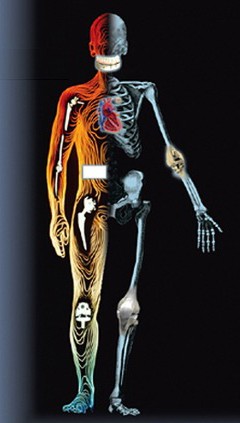
 |
 Biomaterials
are commonly defined as nonviable materials intended to interface with
biological systems to evaluate, treat, augment or replace any tissue, organ or
function of the body. In general, a biomaterial should not be toxic, unless it
is specifically designed for such requirements, a smart drug release system that
seeks out cancer cells and destroys them for example. Biocompatibility is an
essential requirement of any biomaterial, which implies the ability of the
material to perform with an appropriate host response in a specific application.
There are two main factors that determine the biocompatibility of a material:
the host reactions induced by the material, and the
degradation of the material in the body environment (reference).
Biomaterials
are commonly defined as nonviable materials intended to interface with
biological systems to evaluate, treat, augment or replace any tissue, organ or
function of the body. In general, a biomaterial should not be toxic, unless it
is specifically designed for such requirements, a smart drug release system that
seeks out cancer cells and destroys them for example. Biocompatibility is an
essential requirement of any biomaterial, which implies the ability of the
material to perform with an appropriate host response in a specific application.
There are two main factors that determine the biocompatibility of a material:
the host reactions induced by the material, and the
degradation of the material in the body environment (reference).
Most artificial materials, once implanted in the human body, induce a cascade of reactions with the biological environment through interaction of the biomaterial with body fluids, proteins and various cells. The sequence of local events often leads to the classic foreign-body reaction (FBR) and the formation of a fibrous tissue capsule around an implant. The specific reactions at the surface determine the FBR, the path and speed of the healing process, and the long-term development of the biomaterial/body interface.Synthetic biomaterials are generally not immunogenic. However, they typically elicit the FBR, which is a special form of nonimmune inflammation. The most prominent cells in the FBR are macrophages, which presumably attempt to phagocytose the material, with much difficulty.
The response of individual cells to material can be considered to be dependent on how well the material mimics the natural, extracellular environment of the cell. The physical structure of the surface may have an inferior influence on the biological response of the material, which is normally non-toxic and does not release any biologically active substance. One of the issues that arise from the release of corrosion products into the body is systemic and remote effects. In animals and patients with either stainless steel or cobalt-base orthopedic total joint replacement components, corrosion and wear produce longer-term changes in blood composition, primarily in its metal content.
In patients with total joint replacements, large elevations of chromium levels in serum occur in the early postoperative period, significant elevations may persist for more than a decade, and accumulation of 10 to 100 times the normal chromium and nickel levels is possible in tissues remote from the implanted hip. By themselves, metal ions lack the structural complexity required to challenge the immune system. However, when combined with proteins, such as those available in the skin, connective tissues and blood, a wide variety of metals induce immune responses, and thus must be considered harmful. Cobalt, chromium, and nickel are included in this category, with nickel perhaps the most potent. At least 10% of a normal population will be sensitive by skin test to one or more of these metals, at some threshold level.
|
|
 |